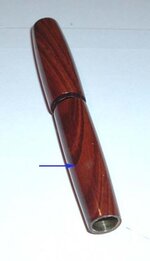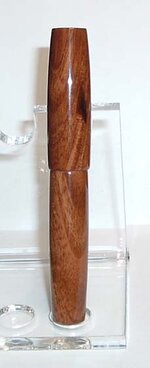Dale Allen
Member
Well, I usually only use 8-10 CA coats and it has been going OK.
Looking at this one under a real strong mag I could still see some real fine scratch marks.
So, I went back and used a 3500 grit Mirka Mirlon scuff pad to knock down those scratches. Probably not the best thing I could have used as it was a bit too aggressive.
Good thing this was just a test and a stock pen. As you can see, there was one tiny spot that went through to the wood.
So, I take off a few layers and begin again.
I guess I'm still learning.:laugh:
Looking at this one under a real strong mag I could still see some real fine scratch marks.
So, I went back and used a 3500 grit Mirka Mirlon scuff pad to knock down those scratches. Probably not the best thing I could have used as it was a bit too aggressive.
Good thing this was just a test and a stock pen. As you can see, there was one tiny spot that went through to the wood.
So, I take off a few layers and begin again.
I guess I'm still learning.:laugh:


